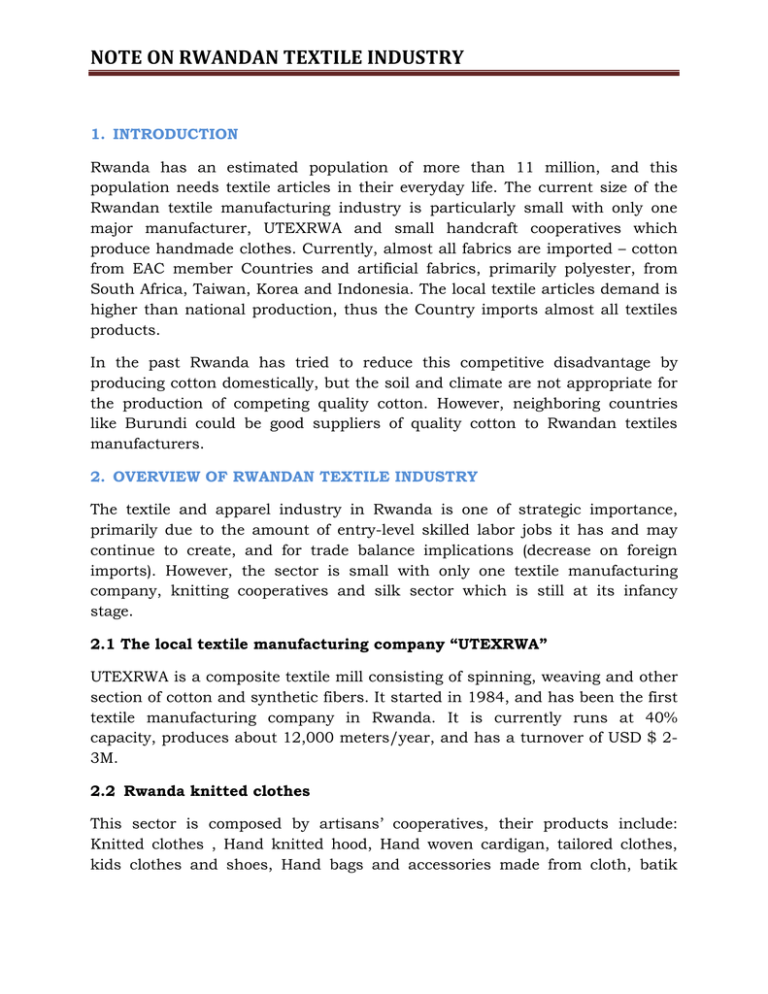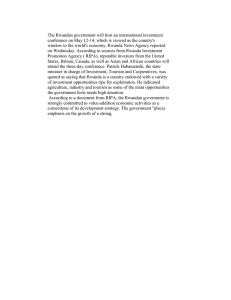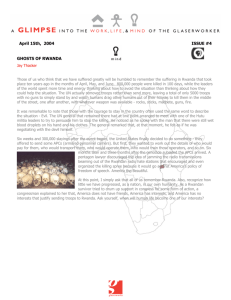Rwandan Textile Industry: Overview & Opportunities
advertisement

NOTE ON RWANDAN TEXTILE INDUSTRY 1. INTRODUCTION Rwanda has an estimated population of more than 11 million, and this population needs textile articles in their everyday life. The current size of the Rwandan textile manufacturing industry is particularly small with only one major manufacturer, UTEXRWA and small handcraft cooperatives which produce handmade clothes. Currently, almost all fabrics are imported – cotton from EAC member Countries and artificial fabrics, primarily polyester, from South Africa, Taiwan, Korea and Indonesia. The local textile articles demand is higher than national production, thus the Country imports almost all textiles products. In the past Rwanda has tried to reduce this competitive disadvantage by producing cotton domestically, but the soil and climate are not appropriate for the production of competing quality cotton. However, neighboring countries like Burundi could be good suppliers of quality cotton to Rwandan textiles manufacturers. 2. OVERVIEW OF RWANDAN TEXTILE INDUSTRY The textile and apparel industry in Rwanda is one of strategic importance, primarily due to the amount of entry-level skilled labor jobs it has and may continue to create, and for trade balance implications (decrease on foreign imports). However, the sector is small with only one textile manufacturing company, knitting cooperatives and silk sector which is still at its infancy stage. 2.1 The local textile manufacturing company “UTEXRWA” UTEXRWA is a composite textile mill consisting of spinning, weaving and other section of cotton and synthetic fibers. It started in 1984, and has been the first textile manufacturing company in Rwanda. It is currently runs at 40% capacity, produces about 12,000 meters/year, and has a turnover of USD $ 23M. 2.2 Rwanda knitted clothes This sector is composed by artisans’ cooperatives, their products include: Knitted clothes , Hand knitted hood, Hand woven cardigan, tailored clothes, kids clothes and shoes, Hand bags and accessories made from cloth, batik NOTE ON RWANDAN TEXTILE INDUSTRY fabric, Decorated fabric, screen printed fabrics, etc, but the production from the sector is still very small compared to the existing demand. 2.3 Rwanda silk sector In the past, Rwanda has tried to produce cotton domestically, but the soil and climate are not appropriate for the production of competing quality cotton. However, preliminary studies and tests indicate that the country could be very well suited for the production of silk. Currently, there is a National Sericulture Centre with four Provincial Sericulture Centres (PSC) and 40 pilot sericulture cooperatives distributed countrywide. Both the centres and cooperatives receive logistical and technical support for sericulture operations. Rwanda’s advantages for sericulture (rearing of silk worms for production of cocoons): Rwanda’s natural conditions provide almost constant temperature of 2028°C throughout the year. These are excellent conditions for rearing silkworm. Furthermore, field temperature of 20-35°C with consistent distribution of rainfall between 1,200-1,700 mm/year is good for mulberry cultivation. Abundant supply of cost effective labour with a variety of successful engagement models between investors and farmers delivers a productive workforce at all levels of the value chain. IFAD and Government funding is already providing support and training to local farmers in both mulberry cultivation and cocoon production. Government plans to extend mulberry cultivation from its current 350 ha to 10,000 ha by 2017 Rwanda’s National Sericulture Centre and the Rwanda Agricultural Board are working together to upgrade silkworm stock through germplasm enrichment with robust and high yielding races adaptable to Rwandan conditions Based on existing activities it is estimated that mulberry density will reach 15,000 per ha. This will provide a yield of 30 boxes of cocoons per ha/year. 3 MARKET OPPORTUNITY Rwanda is a member of various trading regimes that include but unlimited to the East African Customs Union, COMESA, AGOA and others that guarantee NOTE ON RWANDAN TEXTILE INDUSTRY broad market access potential. At a more regional level, for example, COMESA offers a market of 400 Million people that require at least 2.4 Billion meters of fabric per annum, at an average per capita consumption of 6 meters only. On the other hand, under the AGOA initiative, Rwanda has duty and quota free access to United States of America. Rwanda has a population of around 11 million people, requiring 66million meters per annum at the average of 6 meters per capita. At an East African level, the Region has a population of 135 Million people which translates into a market size of 810 Million meters per annum. The table below shows a five-year trend of increasing demand for various categories of textiles in Rwanda as determined from the value of imports. Table 1: Five-year import values of textiles to Rwanda HS code 50 PRODUCTS 2008 2009 2010 2011 2012 Silk 16,910 20,110 60,003 38,442 3,689 51 Wool 2,765 281,349 2,092 7,158 5,208 52 Cotton 2,801,931 1,565,829 2,841,140 2,158,833 2,144,654 53 Other vegetable textile fibres Man-made filaments Man-made staple fibres Wadding, felt and nonwovens Carpets and other textile floor coverings Special woven fabrics; embroidery Impregnated, textiles for industrial use Knitted or crocheted fabrics Clothing accessories, knitted or crocheted Clothing accessories, not knitted or 60,119 38,517 114,509 20,548 60,838 709,160 385,772 605,962 1,091,290 1,332,304 54 55 56 57 58 59 60 61 62 5,289,704 1,119,163 1,068,713 3,398,760 4,819,389 6,781,406 6,416,691 1,270,330 609,437 517,415 892,403 586,396 602,784 678,162 790,461 431,054 385,512 591,661 264,388 286,264 205,282 265,657 24,627 85,570 4,599,383 3,711,751 326,312 204,922 301,235 508,282 304,617 292,412 4,100,246 5,199,176 5,673,828 3,777,908 2,951,152 3,775,641 5,899,276 3,709,286 NOTE ON RWANDAN TEXTILE INDUSTRY crocheted 63 Other made up textile articles; sets 26,843,540 46,783,593 26,104,902 52,758,796 5,922,674 43,960,519 47,590,40 6 68,097,574 40,952,359 TOTAL IMPORTS(USD) 71,252,287 Source: National Institute of Statics of Rwanda This market size is quite significant to justify promising investment in Rwanda in addition to the COMESA and AGOA market potential both of which offer quota and duty free market access. 4 VALUE CHAIN FOR THE LOCAL TEXTILE COMPANY 4.2 Raw materials Most of the raw materials used within the textile industry will come from outside Rwanda (mainly in Burundi and Democratic Republic of Congo (DRC) for cotton. Principle raw materials used in textiles manufacturing process are elaborated upon below: a) Fibers Cotton is imported from producers within the East African region, and the price is consistent with the prevailing price on the world market. Cotton, like most NOTE ON RWANDAN TEXTILE INDUSTRY commodities, experiences significant and often rapid fluctuations in price that result in increased or diminished returns for textile manufacturers, as prices for finished garments and fabrics are not able to fluctuate at the same pace. The other raw fiber used in large quantities, polyester, exhibits some correlation to the price of cotton. Polyester rather than being an agricultural product like cotton is a synthetic fiber manufactured in industry, resulting in lower levels of price volatility. Viscose fiber, another synthetic, has historically been imported and used in production of yarns. b) Yarns and Grey Fabric Some pre-spun yarns and pre-woven fabrics may be imported as the company could not have the capacity to produce the material required (i.e. polyesterviscose yarns) or can purchase for less than it can produce (i.e. pure polyester yarns). c) Dyes and Chemicals Dyes and chemicals are used in the processing division to bleach, chemically treat, dye and print fabrics. They could be imported from Kenya. d) Accessories Accessories are affixed to garments in the garment division. Examples of accessories used in production are zippers, buttons, buckles, and embroidery thread. Accessories are mainly imported from China. e) Fuel and Other Utilities Furnace oil (also called black fuel) is used to heat the boiler that powers the processing department. Electricity and water are purchased from the national supplier ( EWSA). 5 INCENTIVES RELEVANT TO THE SECTOR Investment Benefits: Free initial work permit & visa for investor and foreign workers Assistance with land acquisition and concessions Waiver of import duties, withholding and VAT for imported machinery, equipment and raw materials Waiver of duties for 1 personal vehicle; personal property import NOTE ON RWANDAN TEXTILE INDUSTRY Waiver of duties for special vehicles, trucks & heavy machines Optional: Income tax “investment allowance” of 40% inside; 50% outside Kigali Tax deductible training and research expenses Tax discounts based on the number of jobs created (900+ jobs = 7% discount) Export earnings may secure tax discounts (5 Million USD exported = 5% discount) 6 SECTOR OPERATING COSTS 6.2 WAGES There is no legal minimum wage in Rwanda. However typical private sector salaries faced by investors are indicated in the table. Position Senior manager Unit Value Year Comment USD 1500-3000 2012 per month Middle manager USD 800-1500 2012 per month Graduate entry USD 300-700 2012 per month Engineer USD 300-700 2012 per month Office assistant USD 200-600 2012 per month Highly skilled technician USD 150-200 2012 per month Shop assistant USD 100-200 2012 per month Driver USD 100-200 2012 per month Unskilled laborer USD 80-100 2012 per month Security guard USD 70-90 2012 per month NOTE ON RWANDAN TEXTILE INDUSTRY 6.3 ELECTRICITY AND WATER a) Electricity The Government is working hard to exploit alternative energy sources. By the end of 2012, we expect that methane gas, extracted from lake Kivu will increase supply by 25 MW and double supplies by 2014. This will enable the government to reduce rates for industrial users. Current rates are shown in the table below: Time day Cost/ KWh (USD) 7h00 - 17h00 0.21 17h00 - 23h00 0.28 23h00 - 07h00 0.16 Source: EWSA b) Water Water is provided at the following rates. Unit Value Water USD 0.94 Year 2012 Comment 1 m3 industrial consumption Source:EWSA 6.3 TRANSPORT Rwanda is developing air transport links with a number of key markets in Africa. A new international airport is being planned in Bugesera District with the aim of positioning the country as a central African transport and logistics hub. Road links and border crossings are being upgraded to reduce travel times and costs to EAC neighbours. 6.4 TAXES a) Corporate tax NOTE ON RWANDAN TEXTILE INDUSTRY All companies must register at the Rwanda Revenue Authority. The corporate tax year is based on the calendar year. A taxpayer wishing to use another date must apply to the Minister of Finance and Economic Planning for permission. Losses may be carried forward for up to five years, earlier losses being deducted before later losses. Companies with turnover of less than 200 million RWF may choose to pay their PAYE and VAT on a quarterly instead of monthly basis. Turnover (RWF) Greater than 50 million Tax rate 30 % of profits 12,000,001 to 50 million 3 % of turnover 10,001,000 to 12,000,000 300,000 RWF 7,001,000 to 10,000,000 210,000 RWF 4,001,000 to 7,000,000 2.000,000 to 4,000,000 120,000 RWF 60,000 RWF b) VAT VAT is payable at 18 per cent. Exports of goods and services are zero-rated and, barring need for further verification, refunds take place within 30 days of a claim being made. c) CUSTOM DUTIES As a member of the East African Community (EAC) customs union, all goods manufactured in one EAC country and sold in another and which meet rules of origin criteria (at least 35% value addition) are treated as if they were manufactured locally, by virtue of there being no internal tariffs between partner countries. The same countries also levy a common external tariff for goods entering the EAC, with the aim of promoting manufacturing and the processing of raw materials. Category Tax rate Raw materials 0% Intermediate goods 10 % Finished goods 25% NOTE ON RWANDAN TEXTILE INDUSTRY d) WITHHOLDING TAXES A number of withholding taxes are payable. These are specified in the table. Item Tax rate Withholding tax on payments: dividends; interest on deposits, bonds; royalties, management and technical fees; and performance payments Flat rate of 15 % Withholding tax on imports 5 % on CIF of value of goods imported for commercial use Withholding tax on public tenders 3 % of the sum of the invoice Quarterly prepayment Quarterly prepayment of 25 % of previous income tax declared e) PERSONAL INCOME TAX Annual income or benefit First 360,000 RWF of annual income Between 360,001 and 1,200,000 RWF of annual income Rate 0% 20 % All annual income above 30 % 1,200,000 Company car 10 % of employment income excluding the value of the benefit in kind Accomodation 20 % of employment income excluding the value of the benefit in kind Interest on loan 10 % of income gained as a result of difference between interest paid and what would have been paid if the rate offered to commercial banks by the BNR had been used All other benefits Full market value is added to employment income and taxed as such

